“OUR FATHER”
WITH LITTLE DOUBT – SPOILERS ARE CONTAINED WITHIN!
Tonight’s episode was written by the writing team of Adam Armus and Kay Foster and was directed by veteran HEROES director Jeannot Szwarc.
Kay Foster's Credits
Adam Armus's Credits
Jeannot’s credits
Sadly – as of this episode Kristen Bell departs the show – we loved having her here. She is a pro and an all-around good egg. The scene where Sylar burns her body was her last scene in the series - but I actually directed her on her last day of shooting. This was the scene at the rental car dealership from episode 10. When we wrapped that scene the Assistant Director announced that Kristen was finished in the series. There was a huge round of applause and weepy eyes all around. Tim Kring and Kristen had explored keeping her around longer – and I know Kristen wanted to come back. There were potential storylines about pregnancies and babies…. But the truth is she has a very busy career with a lot of feature films, pilots and much else in the works. We had no official contract with her – and she couldn’t commit to exactly when she could return. And so it was decided that this would be the most exciting way to end her character. She will be missed.
For the very dramatic scene where Sylar burns Elle’s body, we needed somewhere completely isolated and controllable where we would be able to light a fire without any issues or constraints. For some reason that, I know, Jeannot never understood - we ended up at this weird beach in San Pedro. The beach was rocky and stinky and there were hundreds of feral cats living there. It was weird – but maybe the weirdness of the location fed into the weirdness of the scene.
Notably, there was a final shot Jeannot designed for this scene that ended up being cut out. It was a huge crane shot that swooped away as Sylar stood over Elle’s burning body. (See pix below) I remember the script read: “Sylar stands on her burning body. A tinge of remorse. Giving Elle far more respect than any of his previous victims.” Anyway, the shot was very dramatic and I found it very haunting, almost beautiful. But the network standards and practices people and even Tim Kring thought it was too disturbing. So we cut it - and ended up playing the scene on a simple close up Sylar. This works too. I don’t know, maybe America’s not ready for full-on immolation. I like weird disturbing stuff sometimes. I remember reading that one of the techniques of the Hindu and Buddhist priests in India is to go to the pyres where bodies are being burned and meditate upon them. These novices sit for days this way. The idea is that in fully experiencing death in this way they learn to accept their own mortality and hold a looser grip upon life... But, whoa... I digress.
As always my work along with the rest of the production team begins when the first draft of the script is finished. Usually we've read an outline - sometimes not even that. Often we have only a vague idea of what is going to happen until the day we finally get that first draft. This script, by Adam and Kay, was really a nice read with tons of emotion. Most notable were the scenes where Claire ends up in the past with her baby-self and her parents. And most beautiful of all (from my and Jeannot’s point-of-view, at least) was the scene where adult Hiro has a chance to see his dying Mother one last time, to ask for her help, to tell her that he turned out well and to ease her mind that his relationship with his father had been rectified. This scene was very moving on the page and on the stage. It is so full of archetypal resonance and wish fulfillment. Who wouldn’t want to be able to have, as an adult, one last chance to speak with a beloved parent who has passed? All in all a beautiful scene written by Adam and Kay.
It was the scene that Jeannot was most excited to direct and the one he talked through extensively in prep. But fate intervened. Turns out that George Takei was getting married to his longtime partner Brad Altman and afterwards going on a honeymoon. Like Kristen Bell, George is an actor who we write for frequently, but don’t have a contractual hold over. So the scenes in this episode with Kaito in them had to wait until George returned. This ended up being a couple of weeks after Jeannot had wrapped up the rest of the episode and by Jeannot’s schedule had him off to his next gig – an episode of SMALLVILLE.
So the duties of directing all the scenes in the Nakamura apartment fell to me. This is always a heavy burden for me – to direct scenes for another director -especially if they’re the director’s favorite scenes in his episode! I empathized with Jeannot’s disappointment, and I had a long talk with him about the scene before I shot it. In these situations, I always try to talk with the director and try to learn how they were planning to do the scene – both from a technical and an emotional standpoint. I had a similar situation last year when I directed the scene in Dan Attias’ episode 7 - where Hiro leaves behind the swordsmith’s daughter Yaeko, in front of the cherry tree. That was also a simple but emotional scene.
There was a lot of internal debate about wether to have our production designer Ruth Ammon design and build a set for these scenes or wether to find a location. The scenes were meant to happen in the apartment of the Deaveaux building. We've seen that rooftop many times - but the actual apartment hasn't been seen seince the pilot. It needed to be grand and spacious, but we also had to believe it connected to our oft-seen rooftop set. In the end we found a mansion in Pasanena California that Ruth believed felt like a New York Apartment. She built a connecting hallway on stage - so when Hiro and Claire run off camera from the roof set, they first run through this transitional hallway and then onto the practical location. On film, I believe, this complex transition is pretty seamless. In real life, there were huge windows in the mansion that looked out onto big gardens. But we were supposed to be in New York! So, we set up a forty foot tall and sixty foot wide bluescreens outside - so that out the windows the audience would see NYC. It's the same view we see from our rooftop - since, theoretically, it is just one floor below.
I was happy that a lot of time had been dedicated to shoot the main scene – 6 or 7 hours – which is generous by our standards. It is a very long and a very emotionally complex scene. The shooting style is, purposefully simple. The compositions formal – in homage to traditional Japanese cinema. Nate Goodman, the director of photography describes this in this way: “Try to imagine that you have drawn the shot – instead of photographing it. Objects re-compose within the frame, but there is little or no camera movement - unless it is purposeful."
In all these scenes, there are only a few gimmicks used to help the drama. The first is the use of an f.1 50 millimeter lens, which we used when Hiro’s mother kisses the bird. At this low f-stop a very shallow depth-of-field is created. The sick bird is in focus and as the mother leans in, her lips come into focus also. The other moment is when Hiro’s mother kisses his forehead, healing him and restoring his memory. In this moment we ran Hiro’s CU in slow motion and moved the camera in a semi circle around him. Not much moves in the frame besides the background and Hiro’s fluttering eyelids. I feel this nicely accentuates the experience Hiro has as his memory is restored.
Tamyln Tomita played Hiro's Mom. As you can see here, she has a lot of credits: Tamlyn Tomita
Tamlyn was amazing to work with. She nailed the part in the audition and nailed it again and again as we shot. (I first remember her in THE KARATE KID 2.) I shot many takes and many angles of this scene and she was right there every time. At the beginning of the day, Masi, I could sense, was a little nervous. This is an important scene and something unlike anything he had done before on the show – except a little bit with the character of "Charlie" in season one. As a director, I always feel the most important thing to do is to “allow” a space for the actors to work in. It’s not often necessary to come up with all the nuance and subtext that an actor needs in the scene. They are professionals and have done their homework. It’s more important to create a space within the set where they feel safe and supported to experience their emotions publicly. Acting is a very subtle and scary craft in which the actor has to fully experience emotions – often uncomfortable ones – in a space full of crew and lights and many other things that make it "false." On this day I worked gently with Masi, monitoring how he was feeling and letting him know that it was in his close up when he would have to “bring it.” I monitored how he was feeling and I got from him that he wanted to do his close up as the very last shot we did of the scene. When we got there I thought Masi did an amazing job of bringing a very truthful and heartfelt experience to the scene. Unfortunately, after Masi had done just one take, we found ourselves up against the mandatory lunch break. I knew that, now that we were into his performance, we had to complete it. I called the studio and suggested that we needed to go into a “lunch penalty." A lunch penalty is a name for a financial penalty the production incurs for encroaching on the crew's mandated lunch break – we have to pay the crew members each a small bonus for invading their lunch hour. A penalty that lasts a half hour or less costs us several hundred dollars. The studio understood my point. The cameras kept rolling. Two takes and ten minutes later we had the scene in the can. I was very proud of Masi and I’m proud of the scene. My first most important critique came from Jeannot who was very happy. My next will come from you, the fans.
An interesting note is that, on this day, I was working with a second unit crew. A lot of the crew members were just working for us that day and were unfamiliar to me. Many of them had never read the script and weren’t familiar with the story. Furthermore the actors were speaking in Japanese without the benefit of subtitles. So, technically, this crew should have no idea what was happening in the scene. BUT as we were shooting, a couple of times I looked around and noticed a lot of people were tearing up or otherwise having an emotional experience as we shot the scene! It just shows that when truthful, valid emotions are happening they transcend language. Very interesting!
AND NOW – PICTURES, PICTURES, PICTURES….

DIRECTOR JEANNOT SZWARC
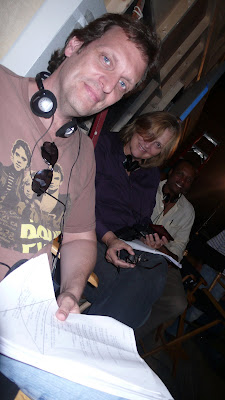
WRITERS’ ADAM ARMUS AND KAY FOSTER
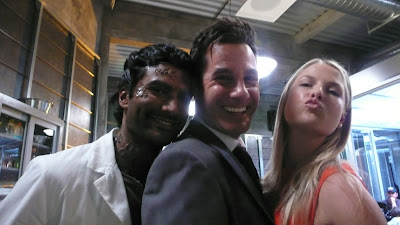
A TRIO OF ACTORS

ALI – GOOFIN’ OFF

SENDHIL – EXPIREMENTS WITH HIS “BUG TONGUE”

UP UP AND AWAY MASI!
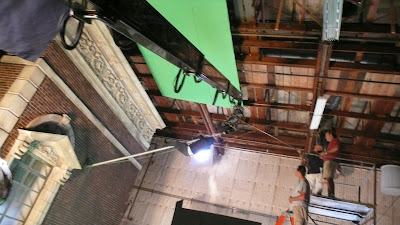
MASI – HANGIN’ AROUND

DAD IS SAD. VERY VERY SAD. HE HAD A BAD DAY. WHAT A BAD DAY DAD HAD.

ZACH AND KRISTEN – ANOTHER DAY ON SET
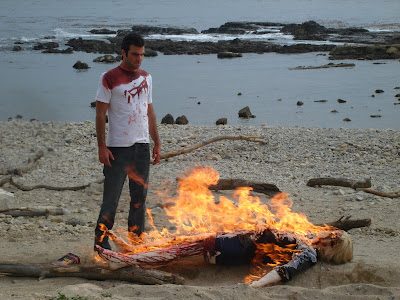
ZACH AND BURNING ELLE

DEAR DIARY: IT'S BEEN KIND OF A WEIRD DAY...

SCALY SENDHIL
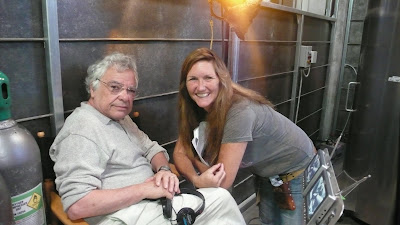
JEANNOT AND FIRST A.D. ANNE BERGER
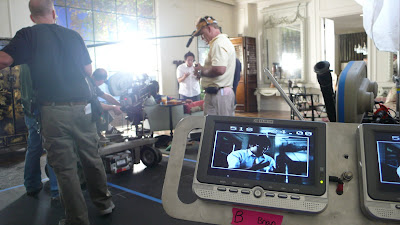
ON SET MONITORS

MASI AND TAMLYN TOMITA
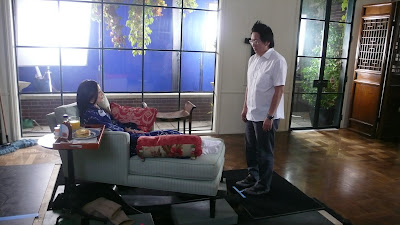
MASI AND MOM – WIDE SHOT
AND A FEW FROM PREVIOUS EPS – I FORGOT TO POST ‘EM BEFORE:

EP 11 – THROUGH THE CAMERA’S VIEWFINDER

EP 7 – JEANNOT AND CRAZY EYED HAYDEN

EP 10 – CAST RELAXES BETWEEN TAKES

EP 10 – GREG G. TRIES TO READ WRITER JOE POKASKI’S THOUGHTS
WITH LITTLE DOUBT – SPOILERS ARE CONTAINED WITHIN!
Tonight’s episode was written by the writing team of Adam Armus and Kay Foster and was directed by veteran HEROES director Jeannot Szwarc.
Kay Foster's Credits
Adam Armus's Credits
Jeannot’s credits
Sadly – as of this episode Kristen Bell departs the show – we loved having her here. She is a pro and an all-around good egg. The scene where Sylar burns her body was her last scene in the series - but I actually directed her on her last day of shooting. This was the scene at the rental car dealership from episode 10. When we wrapped that scene the Assistant Director announced that Kristen was finished in the series. There was a huge round of applause and weepy eyes all around. Tim Kring and Kristen had explored keeping her around longer – and I know Kristen wanted to come back. There were potential storylines about pregnancies and babies…. But the truth is she has a very busy career with a lot of feature films, pilots and much else in the works. We had no official contract with her – and she couldn’t commit to exactly when she could return. And so it was decided that this would be the most exciting way to end her character. She will be missed.
For the very dramatic scene where Sylar burns Elle’s body, we needed somewhere completely isolated and controllable where we would be able to light a fire without any issues or constraints. For some reason that, I know, Jeannot never understood - we ended up at this weird beach in San Pedro. The beach was rocky and stinky and there were hundreds of feral cats living there. It was weird – but maybe the weirdness of the location fed into the weirdness of the scene.
Notably, there was a final shot Jeannot designed for this scene that ended up being cut out. It was a huge crane shot that swooped away as Sylar stood over Elle’s burning body. (See pix below) I remember the script read: “Sylar stands on her burning body. A tinge of remorse. Giving Elle far more respect than any of his previous victims.” Anyway, the shot was very dramatic and I found it very haunting, almost beautiful. But the network standards and practices people and even Tim Kring thought it was too disturbing. So we cut it - and ended up playing the scene on a simple close up Sylar. This works too. I don’t know, maybe America’s not ready for full-on immolation. I like weird disturbing stuff sometimes. I remember reading that one of the techniques of the Hindu and Buddhist priests in India is to go to the pyres where bodies are being burned and meditate upon them. These novices sit for days this way. The idea is that in fully experiencing death in this way they learn to accept their own mortality and hold a looser grip upon life... But, whoa... I digress.
As always my work along with the rest of the production team begins when the first draft of the script is finished. Usually we've read an outline - sometimes not even that. Often we have only a vague idea of what is going to happen until the day we finally get that first draft. This script, by Adam and Kay, was really a nice read with tons of emotion. Most notable were the scenes where Claire ends up in the past with her baby-self and her parents. And most beautiful of all (from my and Jeannot’s point-of-view, at least) was the scene where adult Hiro has a chance to see his dying Mother one last time, to ask for her help, to tell her that he turned out well and to ease her mind that his relationship with his father had been rectified. This scene was very moving on the page and on the stage. It is so full of archetypal resonance and wish fulfillment. Who wouldn’t want to be able to have, as an adult, one last chance to speak with a beloved parent who has passed? All in all a beautiful scene written by Adam and Kay.
It was the scene that Jeannot was most excited to direct and the one he talked through extensively in prep. But fate intervened. Turns out that George Takei was getting married to his longtime partner Brad Altman and afterwards going on a honeymoon. Like Kristen Bell, George is an actor who we write for frequently, but don’t have a contractual hold over. So the scenes in this episode with Kaito in them had to wait until George returned. This ended up being a couple of weeks after Jeannot had wrapped up the rest of the episode and by Jeannot’s schedule had him off to his next gig – an episode of SMALLVILLE.
So the duties of directing all the scenes in the Nakamura apartment fell to me. This is always a heavy burden for me – to direct scenes for another director -especially if they’re the director’s favorite scenes in his episode! I empathized with Jeannot’s disappointment, and I had a long talk with him about the scene before I shot it. In these situations, I always try to talk with the director and try to learn how they were planning to do the scene – both from a technical and an emotional standpoint. I had a similar situation last year when I directed the scene in Dan Attias’ episode 7 - where Hiro leaves behind the swordsmith’s daughter Yaeko, in front of the cherry tree. That was also a simple but emotional scene.
There was a lot of internal debate about wether to have our production designer Ruth Ammon design and build a set for these scenes or wether to find a location. The scenes were meant to happen in the apartment of the Deaveaux building. We've seen that rooftop many times - but the actual apartment hasn't been seen seince the pilot. It needed to be grand and spacious, but we also had to believe it connected to our oft-seen rooftop set. In the end we found a mansion in Pasanena California that Ruth believed felt like a New York Apartment. She built a connecting hallway on stage - so when Hiro and Claire run off camera from the roof set, they first run through this transitional hallway and then onto the practical location. On film, I believe, this complex transition is pretty seamless. In real life, there were huge windows in the mansion that looked out onto big gardens. But we were supposed to be in New York! So, we set up a forty foot tall and sixty foot wide bluescreens outside - so that out the windows the audience would see NYC. It's the same view we see from our rooftop - since, theoretically, it is just one floor below.
I was happy that a lot of time had been dedicated to shoot the main scene – 6 or 7 hours – which is generous by our standards. It is a very long and a very emotionally complex scene. The shooting style is, purposefully simple. The compositions formal – in homage to traditional Japanese cinema. Nate Goodman, the director of photography describes this in this way: “Try to imagine that you have drawn the shot – instead of photographing it. Objects re-compose within the frame, but there is little or no camera movement - unless it is purposeful."
In all these scenes, there are only a few gimmicks used to help the drama. The first is the use of an f.1 50 millimeter lens, which we used when Hiro’s mother kisses the bird. At this low f-stop a very shallow depth-of-field is created. The sick bird is in focus and as the mother leans in, her lips come into focus also. The other moment is when Hiro’s mother kisses his forehead, healing him and restoring his memory. In this moment we ran Hiro’s CU in slow motion and moved the camera in a semi circle around him. Not much moves in the frame besides the background and Hiro’s fluttering eyelids. I feel this nicely accentuates the experience Hiro has as his memory is restored.
Tamyln Tomita played Hiro's Mom. As you can see here, she has a lot of credits: Tamlyn Tomita
Tamlyn was amazing to work with. She nailed the part in the audition and nailed it again and again as we shot. (I first remember her in THE KARATE KID 2.) I shot many takes and many angles of this scene and she was right there every time. At the beginning of the day, Masi, I could sense, was a little nervous. This is an important scene and something unlike anything he had done before on the show – except a little bit with the character of "Charlie" in season one. As a director, I always feel the most important thing to do is to “allow” a space for the actors to work in. It’s not often necessary to come up with all the nuance and subtext that an actor needs in the scene. They are professionals and have done their homework. It’s more important to create a space within the set where they feel safe and supported to experience their emotions publicly. Acting is a very subtle and scary craft in which the actor has to fully experience emotions – often uncomfortable ones – in a space full of crew and lights and many other things that make it "false." On this day I worked gently with Masi, monitoring how he was feeling and letting him know that it was in his close up when he would have to “bring it.” I monitored how he was feeling and I got from him that he wanted to do his close up as the very last shot we did of the scene. When we got there I thought Masi did an amazing job of bringing a very truthful and heartfelt experience to the scene. Unfortunately, after Masi had done just one take, we found ourselves up against the mandatory lunch break. I knew that, now that we were into his performance, we had to complete it. I called the studio and suggested that we needed to go into a “lunch penalty." A lunch penalty is a name for a financial penalty the production incurs for encroaching on the crew's mandated lunch break – we have to pay the crew members each a small bonus for invading their lunch hour. A penalty that lasts a half hour or less costs us several hundred dollars. The studio understood my point. The cameras kept rolling. Two takes and ten minutes later we had the scene in the can. I was very proud of Masi and I’m proud of the scene. My first most important critique came from Jeannot who was very happy. My next will come from you, the fans.
An interesting note is that, on this day, I was working with a second unit crew. A lot of the crew members were just working for us that day and were unfamiliar to me. Many of them had never read the script and weren’t familiar with the story. Furthermore the actors were speaking in Japanese without the benefit of subtitles. So, technically, this crew should have no idea what was happening in the scene. BUT as we were shooting, a couple of times I looked around and noticed a lot of people were tearing up or otherwise having an emotional experience as we shot the scene! It just shows that when truthful, valid emotions are happening they transcend language. Very interesting!
AND NOW – PICTURES, PICTURES, PICTURES….
DIRECTOR JEANNOT SZWARC
WRITERS’ ADAM ARMUS AND KAY FOSTER
A TRIO OF ACTORS
ALI – GOOFIN’ OFF
SENDHIL – EXPIREMENTS WITH HIS “BUG TONGUE”
UP UP AND AWAY MASI!
MASI – HANGIN’ AROUND
DAD IS SAD. VERY VERY SAD. HE HAD A BAD DAY. WHAT A BAD DAY DAD HAD.
ZACH AND KRISTEN – ANOTHER DAY ON SET
ZACH AND BURNING ELLE
DEAR DIARY: IT'S BEEN KIND OF A WEIRD DAY...
SCALY SENDHIL
JEANNOT AND FIRST A.D. ANNE BERGER
ON SET MONITORS
MASI AND TAMLYN TOMITA
MASI AND MOM – WIDE SHOT
AND A FEW FROM PREVIOUS EPS – I FORGOT TO POST ‘EM BEFORE:
EP 11 – THROUGH THE CAMERA’S VIEWFINDER
EP 7 – JEANNOT AND CRAZY EYED HAYDEN
EP 10 – CAST RELAXES BETWEEN TAKES
EP 10 – GREG G. TRIES TO READ WRITER JOE POKASKI’S THOUGHTS
Comments